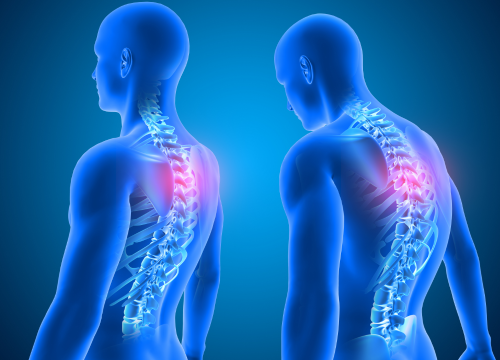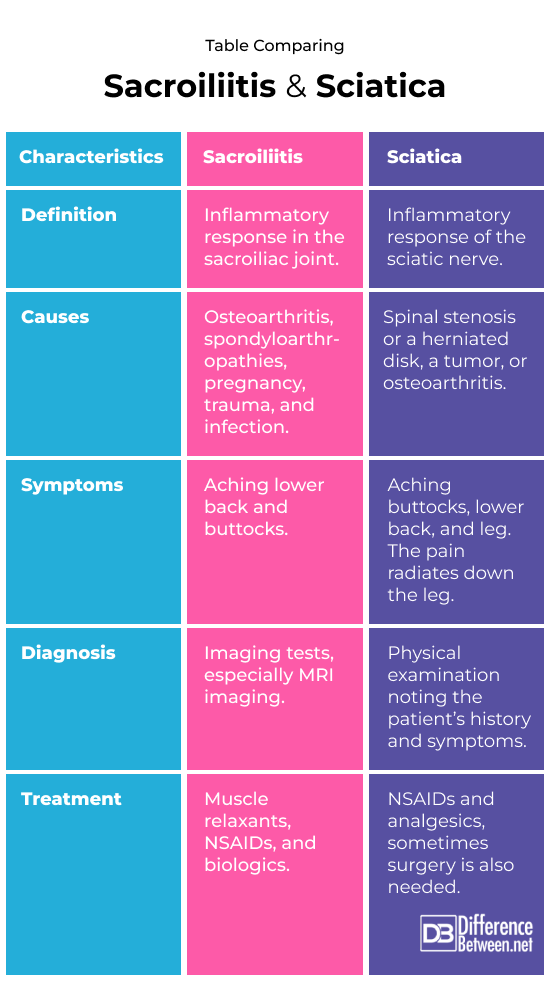Difference Between Sacroiliitis and Sciatica
Sacroiliitis is when there is inflammation of the sacroiliac joint. Sciatic is when there is inflammation of the sciatic nerve.

What is Sacroiliitis?
Definition:
Sacroiliitis is the condition where the sacroiliac joint becomes inflamed. This is the joint between the ilium of the pelvis and the sacrum of the backbone.
Causes:
There are many conditions that can cause sacroiliitis. Some of these conditions include osteoarthritis, spondyloarthropathies, pregnancy, and trauma. Another possible reason you may develop sacroiliitis is if you have an infection. In this case, the condition is called pyogenic sacroiliitis.
Prevalence:
The occurrence of sacroiliitis varies, with the prevalence being about 1 in 10 or 1 in 4 adults who feel pain in their lower back region. In most cases, pain is felt on one side (over 90% of cases), and in the lower back (about 74% of cases).
Symptoms and complications:
Symptoms of sacroiliitis include feeling pain in the buttocks and also in the area of the lower back. These areas may also feel stiff. The pain generally worsens with activity like running or walking, but also if you spend a lot of time standing or sleeping. The person may experience a decrease in their quality of life and have problems sleeping if they have this condition.
Diagnosis:
Imaging tests, specifically MRI imaging, is the best way to diagnose sacroiliitis. The MRI is a good option since it shows details of soft tissues, and can show bone marrow swelling, which is a feature of sacroiliitis.
Treatment:
Treatment options include the use of nonsteroidal anti-inflammatory (NSAIDs) medications, biologic medicines, and muscle relaxants.

What is Sciatica?
Definition:
Sciatica is the condition where the sciatic nerve is inflamed.
Causes:
A person may develop sciatica due to a number of reasons. The possible causes of sciatic include the following: spinal stenosis or a herniated disk, a tumor, or osteoarthritis. Anything that puts pressure on the sciatic nerve can result in sciatica. Physical inactivity and bad posture can increase the odds of you developing sciatica.
Prevalence:
Sciatica is a relatively common problem, affecting an estimated 4 in 10 Americans each year. It is rare for a person under 20 to develop the condition though.
Symptoms and complications:
The person who has sciatica feels pain along the sciatic nerve. The pain is in the lower back, buttocks, and down the leg. The lower back pain is not always present though. There is variation from patient to patient as to exactly where the pain occurs. If not treated the condition can progress, causing numbness of the legs and feet. The person may also have difficulty lifting and bending over.
Diagnosis:
Diagnosis of sciatica is usually made by a doctor based on your medical history and the symptoms.
Treatment:
Sciatica can be treated with a combination of medicine, including anti-inflammatories, analgesic medicine, and, in some cases, surgery to fix a herniated disc (if this is the cause).
Difference between Sacroiliitis and Sciatica?
Definition
Sacroiliitis is an inflammatory response in the sacroiliac joint. Sciatic is an inflammatory response of the sciatic nerve.
Causes
The causes of sacroiliitis include the following: osteoarthritis, spondyloarthropathies, pregnancy, trauma, and infection. The causes of sciatica include the following: spinal stenosis or a herniated disk, a tumor, or osteoarthritis.
Symptoms
An aching lower back and buttocks are symptoms of sacroiliitis. Pain in the buttocks, lower back, and leg are signs of sciatica.
Diagnosis
Sacroiliitis is best diagnosed using an MRI scan, which can show the joint. Sciatica is diagnosed based on the symptoms and the patient’s history.
Treatment
Muscle relaxants, NSAIDs, and biologics can be used as treatment options for patients suffering from sacroiliitis. NSAIDs, analgesics, and sometimes surgery are the treatment options for patients who have sciatica.
Table comparing Sacroiliitis and Sciatica

Summary of Sacroiliitis and Sciatica
- Both sacroiliitis and sciatica can cause a person to experience lower back pain.
- Sacroiliitis is an inflammation of a joint, while sciatica is the inflammation of the sciatic nerve.
- Sciatica more commonly has pain that is not only in the lower back and buttocks, but also radiates down the leg on the affected side.
- For both sciatica and sacroiliitis, NSAIDs can be used to treat the inflammation that is present.
FAQ
How to tell the difference between SI joint pain and sciatica?
The SI joint pain affects the lower back more, while sciatica causes pain in the lower back as well, but this also spreads down the leg on the same, affected side.
Can sacroiliitis cause sciatica?
The sacroiliitis does not result in sciatica.
Does the sacroiliac joint have anything to do with sciatica?
The sacroiliac joint can affect the sciatic nerve and can produce symptoms that are very similar to those seen in sciatica.
What are the three tests to tell you if your back pain is caused by SI?
The three tests to diagnose SI as the cause of back pain includes the following: compression test, distraction test, and sacral thrust test.
Does sacroiliitis ever go away?
Sacroiliitis can go away after three to four weeks, but in 30% of patients, the condition does return.
What aggravates sacroiliitis?
Being in the same position for an extended length of time can aggravate sacroiliitis. This means if you stand for too long, or sit in one position for too long, you may find the condition worsens.
- Difference Between Rumination and Regurgitation - June 13, 2024
- Difference Between Pyelectasis and Hydronephrosis - June 4, 2024
- Difference Between Cellulitis and Erysipelas - June 1, 2024
Search DifferenceBetween.net :
Leave a Response
References :
[0]Barnes, Mariah, Colleen Bush, and Jeffrey Jones. "Pyogenic sacroiliitis: A rare complication of inflammatory bowel disease." The American Journal of Emergency Medicine 37.7 (2019): 1395-e1.
[1]Buchanan, B. K., and M. Varacallo. "Sacroiliitis. 2020 Aug 11." StatPearls [Internet]. Treasure Island (FL): StatPearls Publishing (2021).
[2]Moley, Peter J. “Sciatica”. Merckmanuals. Merck & Co., 2022, https://www.msdmanuals.com/professional/musculoskeletal-and-connective-tissue-disorders/neck-and-back-pain/sciatica
[3]Image credit: https://www.canva.com/photos/MAEE6gw-kE8-doctor-holding-a-card-with-text-sciatica-medical-concept/
[4]Image credit: https://www.canva.com/photos/MAEHEXhhLn4-3d-render-of-the-difference-between-good-and-bad-posture/
